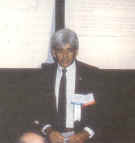By Luis A. Vega, Ph.D. Pacific International Center for High Technology Research 2800 Woodlawn Drive, Honolulu, Hawaii (USA)
The computer-aided design methodology for cold-water-pipe (CWP) suspended from an OTEC plantship is available and has been calibrated with at-sea test data. This summary has been prepared to remind the OTEC community that the design of a CWP is a major issue that has been resolved.

Cold Water Pipe research and development program was implemented in the early 1980's by the U.S. Department of Energy, under the technical direction of the National Oceanic and Atmospheric Administration (NOAA), after careful assessment of the state of ocean engineering knowledge, technology and practice. Clearly, the design of a cost-effective structure to transport large quantities (2.5m3 /s/MW) of cold water from the mid-depths of tropical oceans (~1000m) to the surface was an engineering challenge of significant magnitude complicated by lack of evolutionary experience.
The charge was to develop technology necessary to design, fabricate and operate CWPs of 30' in diameter suspended from surface vessels housing OTEC plants. This R&D program consisted of analytical studies integrated with laboratory and at-sea tests. The greated outcome achieved was the design fabrication, transportation, deployment and operation of a scaled version of the 30' pipe. The test article was a heavily instrumented 8' diameter 400' long fiberglass reinforced plastic sandwich construction (~0.38" laminated, 1.3" syntactic foam core) pipe suspended from a double gimbal attached to a barge moored off Honolulu. (English units are used here fro convenience)
The pipe was fabricated on a rotating mandrel with the core material sprayed in place between inner and outer laminates. Forty-foot pipe sections were butt-jointed at the factory into 80' lengths that were transported to the test site. The 80' lengths were field-jointed into the 400' pipe and the gimbal system was welded to a steel transition overwound into the upper section in the factory. Under strict quality control, nine predetermined stations along the pipe were instrumented with strain gauges as well as one station with differential pressure transducers and accelerometers. Sensor cables were eventually routed to the data-acquisition system aboard the barge. In 1983, the 100-ton pipe/gimbal structure was side-launched into protected waters in Honolulu Harbor. The gimbal was then positioned under the 120' ¡Ñ 34' barge and welded into the moonpool structure. The CWP/barge system was towed two miles to the test site and attached to a predeployed two-point moor. The system was demobilized after three weeks of operation. The instrumentation suite and DAS designed to measure and establish the environmental loading and system structural response were monitored continuously and time history records of wave height, water velocity profile, barge motions, gimbal angles and strains along the pipe were obtained under all aspects of operation and varying environmental conditions. Costs incurred in all aspects of the project, from design to demobilization, were gathered and documented providing invaluable information for future reference.
Data collected during the at-sea test has been reduced and analyzed. In particular, the response of the 8-foot diameter pipe suspended from a barge was experimentally evaluated for the first time. Power spectra for sea states, corresponding barge motions and pipe bending strains were estimated from the available time history records. Causal relationships were established, as well as the coupled behavior of the barge-pipe system. Experimental values of pipe drag and pipe added-mass coefficients were obtained for high Reynolds numbers, thus extending a previously incomplete data base. Special attention was also given to the statistical distribution of peaks and how it should be accounted for in the design process.
Although the results of the at-sea test data analysis show that the design methodology adopted for the OTEC project is globally sound, considerable knowledge has been gained, through the interpretation of the data, to refine the design process, make it more cost effective, and to validate existing computer models. For example, it was determined that for the CWP tested at-sea bending of the pipe in its first two modes dominates other dynamic responses under typical excitations. It was also confirmed that the barge/pipe system
